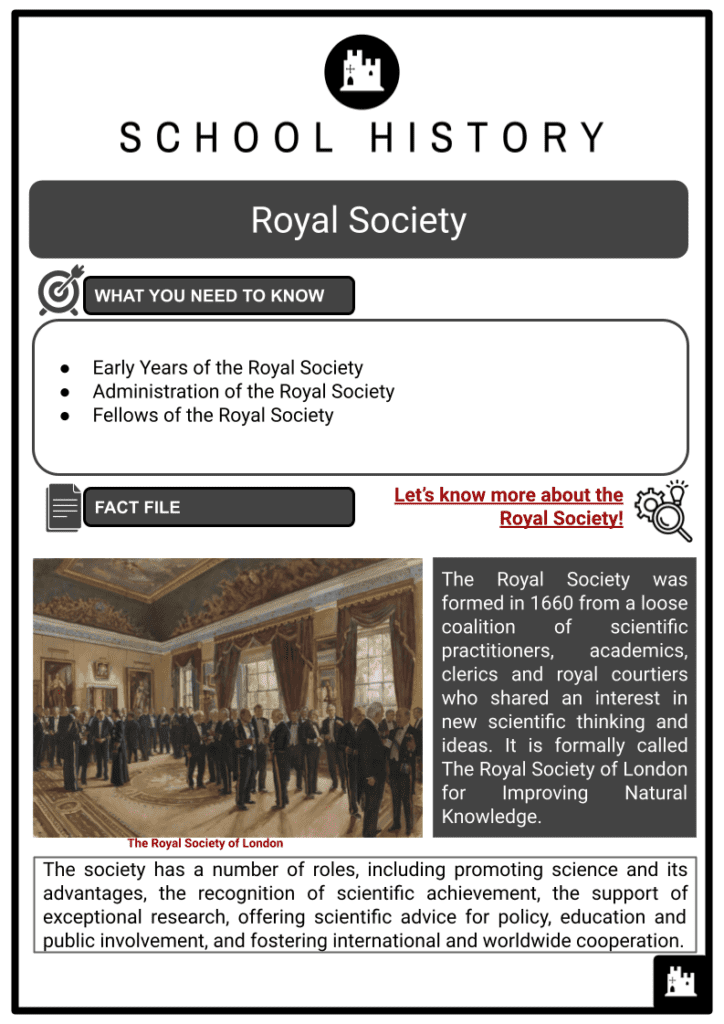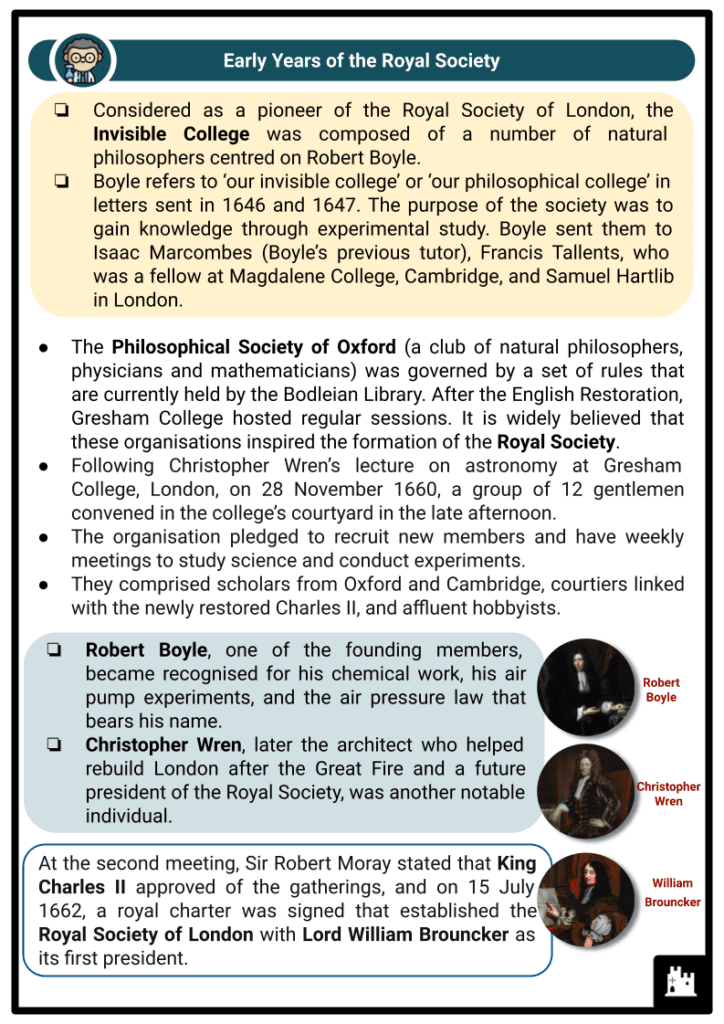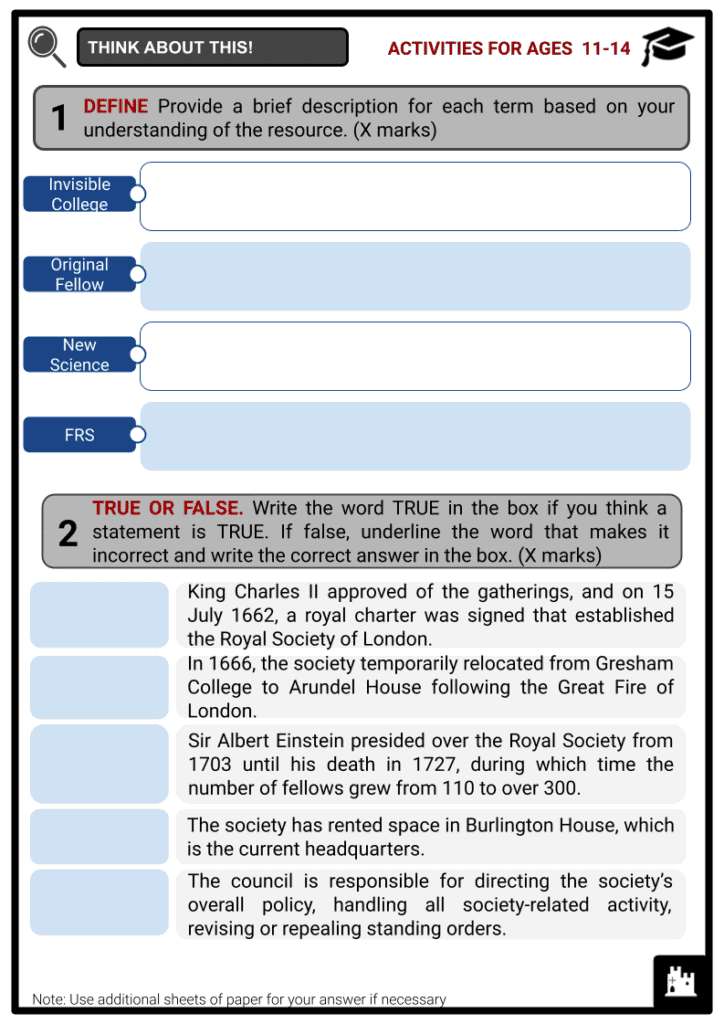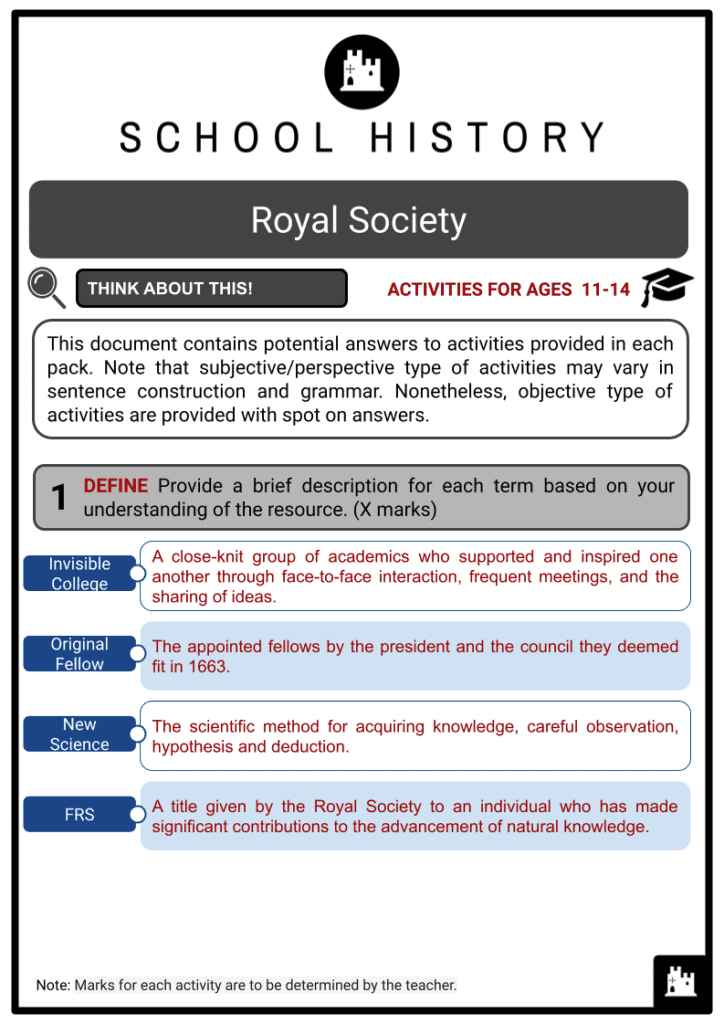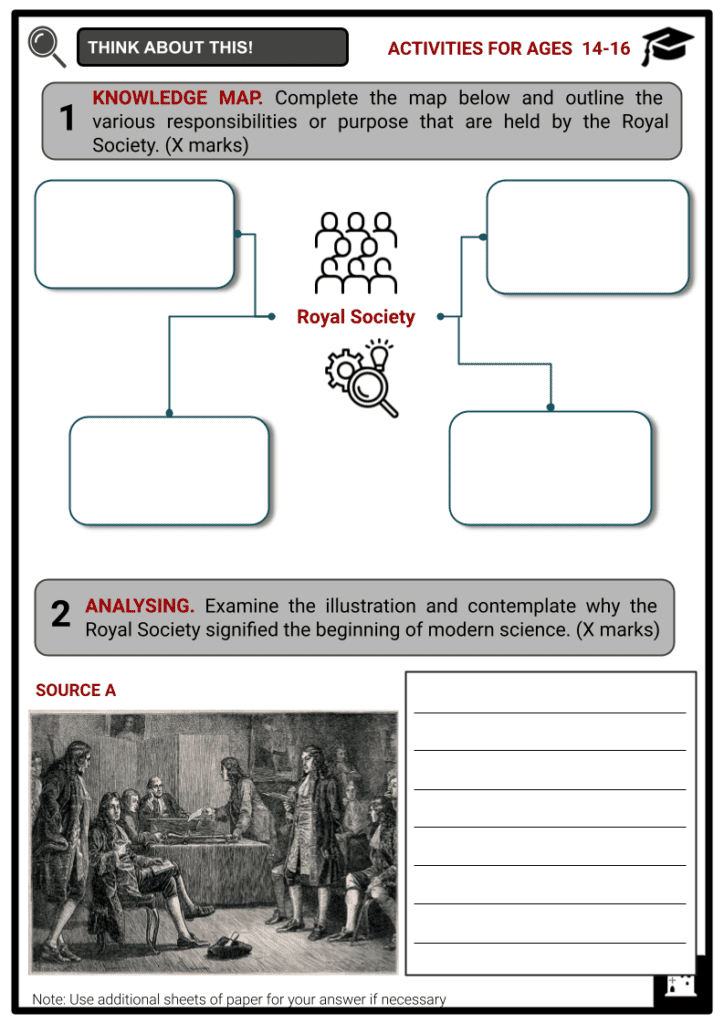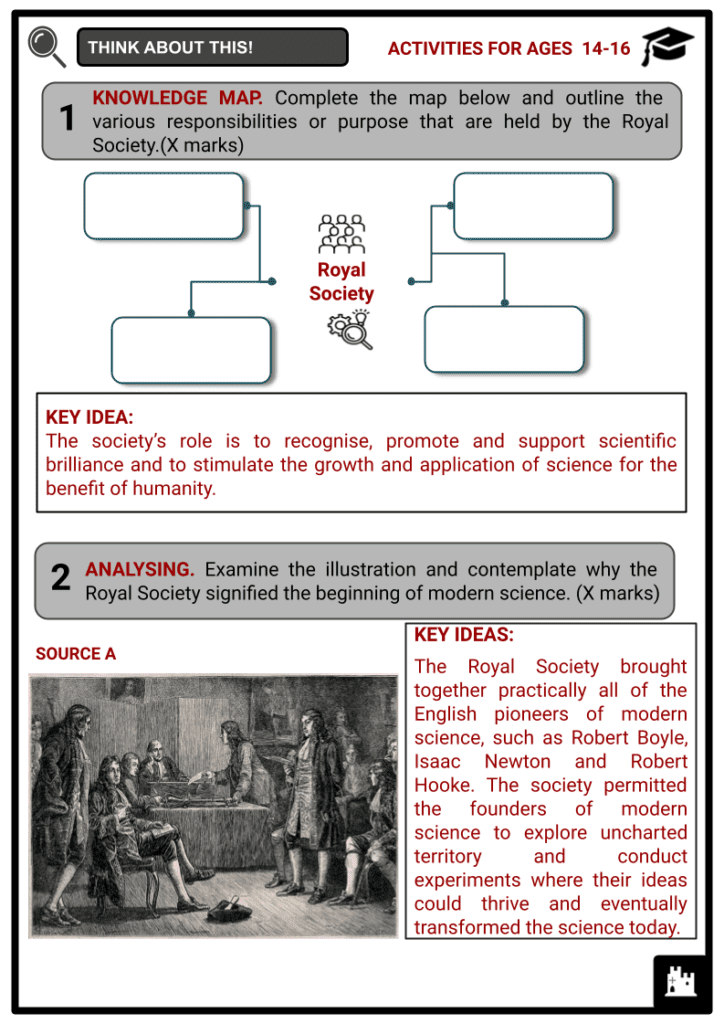Royal Society Worksheets
Do you want to save dozens of hours in time? Get your evenings and weekends back? Be able to teach about the Royal Society to your students?
Our worksheet bundle includes a fact file and printable worksheets and student activities. Perfect for both the classroom and homeschooling!
Summary
- Early Years of the Royal Society
- Administration of the Royal Society
- Fellows of the Royal Society
Key Facts And Information
Let’s know more about the Royal Society!
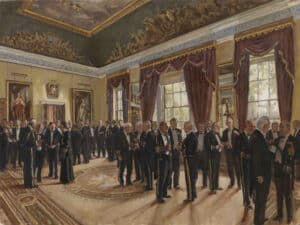
The Royal Society was formed in 1660 from a loose coalition of scientific practitioners, academics, clerics and royal courtiers who shared an interest in new scientific thinking and ideas. It is formally called The Royal Society of London for Improving Natural Knowledge. The society has a number of roles, including promoting science and its advantages, the recognition of scientific achievement, the support of exceptional research, offering scientific advice for policy, education and public involvement, and fostering international and worldwide cooperation.
Early Years of the Royal Society
- Considered as a pioneer of the Royal Society of London, the Invisible College was composed of a number of natural philosophers centred on Robert Boyle.
- Boyle refers to ‘our invisible college’ or ‘our philosophical college’ in letters sent in 1646 and 1647. The purpose of the society was to gain knowledge through experimental study. Boyle sent them to Isaac Marcombes (Boyle’s previous tutor), Francis Tallents, who was a fellow at Magdalene College, Cambridge, and Samuel Hartlib in London.
- The Philosophical Society of Oxford (a club of natural philosophers, physicians and mathematicians) was governed by a set of rules that are currently held by the Bodleian Library. After the English Restoration, Gresham College hosted regular sessions. It is widely believed that these organisations inspired the formation of the Royal Society.
- Following Christopher Wren’s lecture on astronomy at Gresham College, London, on 28 November 1660, a group of 12 gentlemen convened in the college’s courtyard in the late afternoon.
- The organisation pledged to recruit new members and have weekly meetings to study science and conduct experiments.
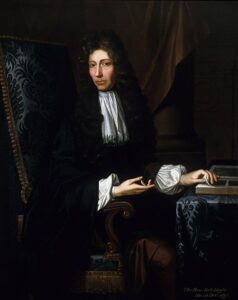
Robert Boyle - They comprised scholars from Oxford and Cambridge, courtiers linked with the newly restored Charles II, and affluent hobbyists.
- Robert Boyle, one of the founding members, became recognised for his chemical work, his air pump experiments, and the air pressure law that bears his name.
- Christopher Wren, later the architect who helped rebuild London after the Great Fire and a future president of the Royal Society, was another notable individual.
- At the second meeting, Sir Robert Moray stated that King Charles II approved of the gatherings, and on 15 July 1662, a royal charter was signed that established the Royal Society of London with Lord William Brouncker as its first president.
- On 23 April 1663, a second royal charter was issued with the King listed as the founder and the name The Royal Society of London for the Improvement of Natural Knowledge. In November, Robert Hooke was named as Curator of Experiments.
- The royal charter established the society’s institutional framework, including a president, treasurer, secretaries and a council. The society has always been a voluntary organisation, independent of the British government, although receiving royal sponsorship from the beginning.
- Among the many functions that the society performs are the promotion of science and its benefits, the recognition of scientific excellence, the support of exceptional scientific research, the provision of scientific advice for policy making, and the promotion of international and global cooperation in research, education and public engagement.
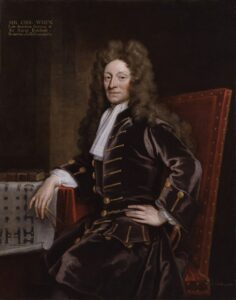
Christopher Wren - Robert Hooke and then Denis Papin, who was appointed in 1684, conducted experiments during the earliest meetings of the club. The subjects of these experiments varied, with some being crucial while others were insignificant. Hooke’s most renowned contribution was the microscope. His discoveries were published in the legendary Micrographia, which featured breathtaking enlargements of insects, plants, minerals and everyday things.
- In 1666, the society temporarily relocated from Gresham College to Arundel House following the Great Fire of London, which did not damage Gresham but did result in its acquisition by the Lord Mayor. In 1673, the society returned to Gresham.
- Sir Isaac Newton presided over the Royal Society from 1703 until his death in 1727, during which time the number of fellows grew from 110 to over 300, and editions of the Philosophical Transactions began to be published regularly as the society’s voice.
- Since the 18th century, endowments have made it feasible to present prizes for various branches of research: the Copley Medal, which originated from a 1709 gift by Sir Godfrey Copley, is the most distinguished scientific award in Britain.
- In the late 18th century, the society actively promoted scientific exploration, particularly under the leadership of its longest-serving president, Sir Joseph Banks, who accompanied James Cook on his epic voyage of discovery from 1768 to 1772.
- Nonetheless, during the 18th and early 19th centuries, the society tended to rest on its achievements and became somewhat unprofessional. This was remedied in the 1830s by a reform programme that revitalised and reestablished the society’s importance, which it has maintained ever since.
- In 1919, the society dispatched teams to photograph the 29 May solar eclipse from Príncipe Island in the Gulf of Guinea and from Sobral in Brazil, which helped to validate Albert Einstein’s general theory of relativity and boost his fame.
- The first women were elected to the Royal Society’s Fellowship on 22 March 1945. Chapter 1 of Statute 1 was amended in 1944 to read ‘Nothing herein included shall render women disqualified as candidates,’ and this was the turning point for the change.
- Mary Cartwright was elected as the first female mathematician to be a fellow of the Royal Society in 1947.
- There are currently roughly 1,300 fellows and 130 international members. Since 1967, the group has rented space in Carlton House Terrace, London, where it holds meetings and stores its vast archives and other resources.
Administration of the Royal Society
- The society is managed by its council, presided over by its president. The members of the council and the president are elected from and by fellows, the society’s fundamental members, who are in turn elected by fellows already in existence.
- The council is made up of 21 fellows, including the officers (the president, the treasurer, two secretaries from the physical sciences and one from the biological sciences, and the foreign secretary), one fellow to represent each section, and seven other fellows.
-
- President: Adrian Smith
- Treasurer: Andy Hopper
- Biological Secretary: Linda Partridge
- Physical Secretary: Peter Bruce
- Foreign Secretary: Robin GrimesThe present officers are:
Coat of Arms. The first fellows chose ‘Nullius in verba’ as their motto and a blank slate as their symbol. The motto and coat of arms evoked their idea of gaining fresh knowledge by direct experience rather than relying on what other people say is true.
- The society is supported by a number of salaried permanent employees. The original charter stipulated ‘two or more Operators of Experiments and two or more clerks’. When the society’s book collection increased, it became necessary to hire a curator as well. As the society’s financial situation improved, the personnel grew to include mostly outsiders and a limited number of scientists who were compelled to relinquish their fellowship upon hiring.
- The council is responsible for directing the society’s overall policy, handling all society-related activity, revising, creating or repealing standing orders, and acting as trustees for the society’s assets and estates. In accordance with the existing standing rules, at least ten seats must change hands annually. Members are elected annually via postal ballot.
- The society has numerous functions and pursuits. It funds roughly 600 research fellowships for early and late career scientists, in addition to innovation, mobility and research capacity grants totalling nearly £42 million.
- It gives out awards, prize lectures, and medals that come with prize money to help pay for research. It also helps pay for research scientists to take courses in communication and media skills.
Publishing
- In 1665, the society published Philosophical Transactions, the world’s first journal devoted solely to science. In doing so, it initiated the peer review method that is today popular in scientific journals. The society’s first secretary, Henry Oldenburg, was also its founding editor.
- It is the world’s oldest and longest-running scientific journal. Since 1886, it has been categorised into two sections: A, which covers mathematics and the physical sciences, and B, which covers the biological sciences.
- Proceedings of the Royal Society is composed of freely submitted research articles and is separated into two sections in the same manner. Biology Letters, which came out for the first time in 2005, has short research articles and points of view from different areas of biology.
- Journal of the Royal Society Interface features articles from researchers working across traditional scientific disciplines at the interface of the physical and life sciences, while its sister publication, Interface Focus, offers thematic issues on similar topics.
Fellows of the Royal Society
- The fellows are the backbone of the society, consisting of scientists and engineers from the United Kingdom and the Commonwealth who have made a considerable contribution to the enhancement of natural knowledge, including mathematics, engineering science, and medicine.
- Members of the Royal Society are able to use the honorific "Fellow of the Royal Society" (FRS) after their names once they have been elected as Fellows for life.
- On 22 April 1663, the president and council were granted the authority to designate fellows whomever they deemed suitable within two months of the charter's signing. Consequently, 94 fellows were appointed on 20 May and 4 fellows on 22 June; these 98 fellows are known as the "Original Fellows."
- Each year, up to 52 new fellows can be inducted, and as of 2014, there were approximately 1,450 active members. The 10 committees made up of current fellows decide who gets elected to the fellowship.
- In addition, the society elects royal fellows, honorary fellows, and international members.
- Royal fellows are members of the British Royal Family who are proposed by the society's council and elected by postal ballot.
- Honorary fellows are those who are ineligible for election as fellows but have made significant contributions to the cause of science, or whose election would benefit society significantly due to their vast knowledge in other fields.
- Foreign members are scientists from non-Commonwealth countries who are distinguished for their scientific achievements and discoveries.
- Since the Society's founding in 1660, there have been over 8,000 Fellows, including over 280 Nobel laureates. Among the renowned individuals who have had the title "FRS" are Isaac Newton, Albert Einstein, Charles Darwin, Ernest Rutherford, Michael Faraday, Dorothy Hodgkin, Anne McLaren, Alan Turing, and Stephen Hawking.
- Many of the early fellows were not scientists or prominent thinkers; it was evident that the early organisation could not rely on financial help from the king, and scientifically educated fellows were scarce. For the sake of the society's preservation, it was consequently crucial to gain the favour of wealthy or influential individuals. While the admission fee of £4 and the subscription rate of one shilling per week should have generated £600 per year for the society, many fellows did not pay on time or on schedule.

